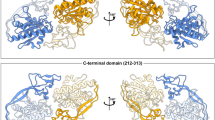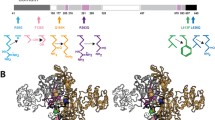Abstract
Canavan disease (CD) is a fatal neurological disorder caused by defects in the gene that encodes for a critical metabolic enzyme. The enzyme aspartoacylase catalyzes the deacetylation of N-acetylaspartate to produce acetate required for fatty acid biosynthesis in the brain. The loss of aspartoacylase activity leads to the demyelination and disrupted brain development that is found in CD patients. Sixteen different clinical mutants of aspartoacylase have been cloned, expressed and purified to examine their properties and the relationship between enzyme properties and disease phenotype. In contrast to numerous cell culture studies that reported virtually complete loss of function, each of these purified mutant enzymes was found to have measureable catalytic activity. However, the activities of these mutants are diminished, by as little as three-fold to greater than 100-fold when compared to the native enzyme. Many of these mutated enzyme forms show decreased thermal stability and an increased propensity for denaturation upon exposure to urea, but only four of the 16 mutants examined showed both diminished thermal and diminished conformational stability. Significantly, each of these lower stability mutants are responsible for the more severe phenotypes of CD, while patients with milder forms of CD have aspartoacylase mutants with generally high catalytic activity and with either good thermal or good conformational stability. These results suggest that the loss of catalytic function and the accumulation of N-acetylaspartate in Canavan disease is at least partially a consequence of the decreased protein stability caused by these mutations.

Similar content being viewed by others
References
Adachi M, Schneck L, Cara J, Volk BW (1973) Spongy degeneration of the central nervous system (Van Bogaert and Bertrand type; Canavan’s disease). Human Pathol 4:331–347
Adornato BT, O’Brien JS, Lampert PW, Roe TF, Neustein HB (1972) Cerebral spongy degeneration of infancy: a biochemical and ultrastructural study of affected twins. Neurology 22:202–210
Almarza J, Rincon L, Bahsas A, Brito F (2009) Molecular mechanism for the denaturation of proteins by urea. Biochemistry 48:7608–7613
Canavan MM (1931) Schindler’s Encephalitis Periaxialis Diffusa. Arch Neurol Psychiat 25:299–308
Elpeleg ON, Shaag A (1999) The spectrum of mutations of the aspartoacylase gene in Canavan disease in non-Jewish patients. J Inher Metabol Dis 22:531–544
Globus JH, Strauss I (1928) Progressive degenerative subcortical encephalophaty (Schilder’s disease). Arch Neurol Psychiat 20:1190–1228
Hershfield JR, Pattabiraman N, Madhavarao CN, Namboodiri MA (2007) Mutational analysis of aspartoacylase: implications for canavan disease. Brain Res 1148:1–14
Janson CG, Kolodny EH, Zeng BJ, Raghavan S, Pastores GM, Torres P et al (2006) Mild-onset presentation of Canavan’s disease associated with novel G212A point mutation in aspartoacylase gene. Ann Neurol 59:428–431
Karsten WE, Hunsley JR, Viola RE (1985) Purification of aspartase and aspartokinase-homoserine dehydrogenase I from Escherichia coli by Dye-Ligand chromatography. Anal Biochem 147:336–341
Kaul R, Balamurugan K, Gao GP, Matalon R (1994a) Canavan disease: genomic organization and localization of human ASPA to 17p13-ter and conservation of the ASPA gene during evolution. Genomics 21:364–370
Kaul R, Gao GP, Aloya M, Balamurugan K, Petrosky A, Michals-Matalon K et al (1994b) Canavan disease: mutations among Jewish and non-Jewish patients. Am J Hum Genet 55:34–41
Kaul R, Gao GP, Michals-Matalon K, Whelan DT, Levin S, Matalon R (1995) Novel (cys152 > arg) missense mutation in an Arab patient with Canavan disease. Hum Mutat 5:269–271
Kobayashi, K, Tsujino, S, Ezoe, T, Hamaguchi, H, Nihei, K, Sakuragawa, N (1998) Missense mutation (I143T) in a Japanese patient with Canavan disease. Human Mutation S308–S309
Le Coq J, An HJ, Lebrilla CB, Viola RE (2006) Characterization of human aspartoacylase: the brain enzyme responsible for Canavan disease. Biochemistry 45:5878–5884
Le Coq J, Pavlovsky A, Malik R, Sanishvili R, Xu C, Viola RE (2008) Examination of the mechanism of human brain aspartoacylase through the binding of an intermediate analogue. Biochemistry 47:3484–3492
Lim WK, Rosgen J, Englander SW (2009) Urea, but not guanidinium, destabilizes proteins by forming hydrogen bonds to the peptide group. Proc Natl Acad Sci USA 106:2595–2600
Matalon R, Kaul R, Michals K (1993) Canavan disease: biochemical and molecular studies. J Inher Metabol Dis 16:744–752
Matalon R, Michals-Matalon K, Sebesta M, Deanching M, Gashkoff P, Casanova J (1988) Aspartoacylase deficiency and N-acetylaspartic aciduria in patients with Canavan disease. Am J Med Genet 29:463–471
Moore RA, Le Coq J, Faehnle CR, Viola RE (2003) Purification and preliminary characterization of brain aspartoacylase. Arch Biochem Biophys 413:1–8
Shaag A, Anikster Y, Christensen E, Glustein JZ, Fois A, Michelakakis H et al (1995) The molecular basis of Canavan (aspartoacylase deficiency) disease in European non-Jewish patients. Am J Hum Genet 57:572–580
Surendran S, Bamforth FJ, Chan A, Tyring SK, Goodman SI, Matalon R (2003) Mild elevation of N-Acetylaspartic acid and macrocephaly: diagnostic problem. J Child Neurol 18:809–812
Tacke U, Olbrich H, Sass JO, Fekete A, Horvath J, Ziyeh S et al (2005) Possible genotype-phenotype correlations in children with mild clinical course of Canavan disease. Neuropediatrics 36:252–255
Traeger EC, Rapin I (1998) The clinical course of Canavan disease. Pediatr Neurol 18:207–212
van Bogaert L, Bertrand L (1949) Sur une idiotie familiale avec dégénérescence spongieuse du névraxe. Acta Neur Psychiatr Belg 49:572–585
Yalcinkaya C, Benbir G, Salomons GS, Karaarslan E, Rolland MO, Jakobs C et al (2005) Atypical MRI findings in Canavan disease: a patient with a mild course. Neuropediatrics 36:336–339
Zeng BJ, Wang ZH, Ribeiro LA, Leone P, De Gasperi R, Kim SJ et al (2002) Identification and characterization of novel mutations of the aspartoacylase gene in non-Jewish patients with Canavan disease. J Inher Metabol Dis 25:557–570
Zhang H, Liu X, Gu X (2010) Two novel missense mutations in the aspartoacylase gene in a Chinese patient with congenital Canavan disease. Brain Dev 32:879–882
Acknowledgements
This work was supported by a grant from the Canavan Research Foundation. The authors thank Grace Ann Maltbie (University of Toledo) for assembling the disease phenotype data.
Conflict of interest
None.
Author information
Authors and Affiliations
Corresponding author
Additional information
Communicated by: Robert Steiner
Rights and permissions
About this article
Cite this article
Zano, S., Wijayasinghe, Y.S., Malik, R. et al. Relationship between enzyme properties and disease progression in Canavan disease. J Inherit Metab Dis 36, 1–6 (2013). https://doi.org/10.1007/s10545-012-9520-z
Received:
Revised:
Accepted:
Published:
Issue Date:
DOI: https://doi.org/10.1007/s10545-012-9520-z




